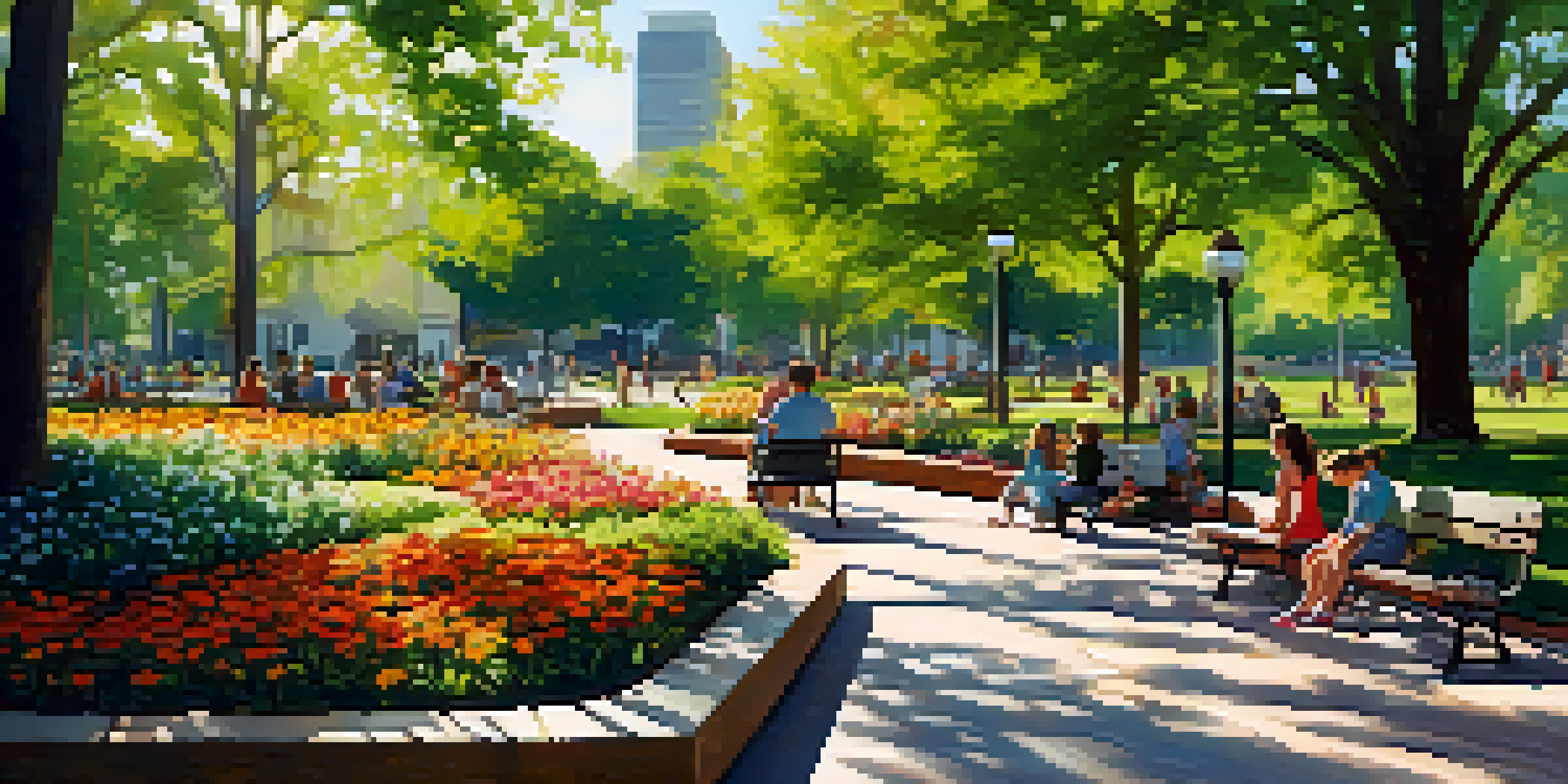Charlotte's Urban Heat Island Effect: Causes and Solutions

What is the Urban Heat Island Effect in Charlotte?
The Urban Heat Island (UHI) effect refers to urban areas becoming significantly warmer than their rural surroundings. This temperature difference is mainly due to human activities and the materials used in city infrastructure. In Charlotte, this phenomenon can lead to increased energy consumption, elevated emissions, and compromised air quality. Understanding UHI is crucial for developing effective mitigation strategies.
Cities are like ecosystems: they can be designed to be more sustainable and to work in harmony with nature.
Charlotte, with its rapid urbanization and extensive concrete surfaces, is particularly susceptible to UHI. As more buildings and roads replace natural landscapes, the city absorbs and retains heat. This can make summers feel hotter, leading to discomfort for residents and increased demand for cooling systems. Addressing UHI is vital for ensuring a livable climate in this growing metropolis.
The UHI effect not only impacts temperatures but also influences local ecosystems and biodiversity. Urban heat can disrupt the natural behaviors of wildlife, affecting their survival rates. As a result, tackling UHI involves considering both human comfort and the well-being of local wildlife.
Key Causes of the Urban Heat Island Effect in Charlotte
One of the primary causes of UHI in Charlotte is the extensive use of concrete and asphalt in urban development. These materials absorb and retain heat much more than natural vegetation, which cools the air through shade and evapotranspiration. As Charlotte continues to expand, replacing greenspaces with hard surfaces exacerbates this heat retention.

Another contributing factor is the lack of vegetation in urban areas, which can mitigate heat effects. Trees and plants play a crucial role in cooling the environment through shade and moisture release. However, in many neighborhoods, trees are being removed for new construction, further intensifying the heat island effect.
Urban Heat Impact in Charlotte
The Urban Heat Island effect makes Charlotte significantly warmer than its rural surroundings, affecting energy consumption and air quality.
Finally, human activities, such as transportation and industrial processes, add to the heat. Increased vehicular traffic and energy consumption from buildings contribute significantly to local warming. As the city grows, these activities will need to be managed carefully to reduce their impact on the climate.
Impact of Urban Heat Island on Charlotte's Residents
The UHI effect can significantly affect the daily lives of Charlotte's residents, particularly during the summer months. Higher temperatures can lead to increased energy costs as air conditioning units work overtime to cool homes and businesses. This added financial burden can be especially challenging for low-income families.
The best way to predict the future is to create it.
Health is another concern linked to the UHI effect. Increased temperatures can worsen air quality, leading to respiratory issues and heat-related illnesses. Vulnerable populations, such as the elderly and those with pre-existing health conditions, may be at greater risk during heat waves, necessitating community awareness and preparedness.
Moreover, the UHI effect can influence outdoor activities and community engagement. High temperatures may discourage residents from spending time outside, impacting social interactions and physical health. Developing solutions to mitigate UHI could help foster a more active and connected community.
Exploring Solutions to Combat UHI in Charlotte
One effective solution to mitigate the UHI effect is increasing urban greenery. Planting more trees and creating green spaces, such as parks and community gardens, can significantly lower temperatures. These areas not only provide shade but also contribute to improved air quality and enhanced biodiversity.
Another strategy involves implementing green roofs and walls on buildings. These living structures can absorb heat, reduce energy costs, and improve aesthetics. Encouraging developers and homeowners to adopt green technology can play a significant role in cooling urban areas.
Need for Increased Urban Greenery
Enhancing urban greenery through trees and parks is crucial for cooling Charlotte and improving biodiversity.
Lastly, promoting sustainable transportation options, like biking and public transit, can help reduce the heat generated by vehicles. By creating a more walkable and bike-friendly city, Charlotte can decrease reliance on cars, which would not only help to lower temperatures but also improve overall air quality.
Community Initiatives Addressing UHI in Charlotte
Charlotte has seen several community-driven initiatives aimed at combating UHI. Local organizations are working to educate residents about the benefits of urban greenery and the importance of tree planting. Programs that involve community members in planting and maintaining trees can foster a sense of ownership and responsibility towards their environment.
In addition to tree planting, various local government initiatives are promoting the installation of green roofs on public buildings. These projects not only serve as a model for private developers but also highlight the city's commitment to sustainability. Such initiatives can inspire residents to adopt similar practices in their homes and businesses.
Furthermore, community workshops and events focusing on sustainable living practices are gaining traction. These gatherings provide opportunities for residents to learn about energy-efficient technologies and alternative transportation options, empowering them to take an active role in reducing UHI impacts.
Role of Policy in Mitigating Charlotte's UHI Effect
Effective policy is essential in addressing the UHI effect in Charlotte. Local government can implement zoning laws that promote green spaces and limit the development of heat-retaining surfaces. By prioritizing sustainability in urban planning, the city can create a more resilient environment for future generations.
Additionally, policies that incentivize homeowners and businesses to adopt green technologies can significantly contribute to UHI mitigation. Tax breaks or grants for installing energy-efficient systems or green roofs can encourage widespread participation. Such policies not only help cool the city but also boost the local economy.
Community Initiatives for UHI
Local initiatives focused on tree planting and sustainable living aim to empower residents in combating the Urban Heat Island effect.
Finally, collaboration between various stakeholders, including city planners, environmental groups, and community members, is crucial. By fostering dialogue and partnership, Charlotte can create a comprehensive strategy to effectively combat the UHI effect while enhancing the community's overall quality of life.
The Future of Charlotte with Reduced UHI Impact
Envisioning a future for Charlotte with a reduced UHI impact involves a commitment to sustainable development and community engagement. By prioritizing green infrastructure and energy-efficient practices, the city can create a more comfortable climate for its residents. This vision not only enhances livability but also positions Charlotte as a leader in urban sustainability.
As more residents and stakeholders become involved in UHI mitigation efforts, the potential for positive change grows. Community-driven initiatives can inspire a cultural shift towards valuing nature and sustainability, making the city more resilient against climate challenges. Working together can foster a sense of pride in the community and its environment.

Ultimately, addressing the UHI effect is not just about cooling the city; it’s about creating a healthier, more vibrant Charlotte for everyone. The collaborative efforts of residents, businesses, and policymakers will be key in transforming this vision into reality, ensuring a sustainable future for generations to come.